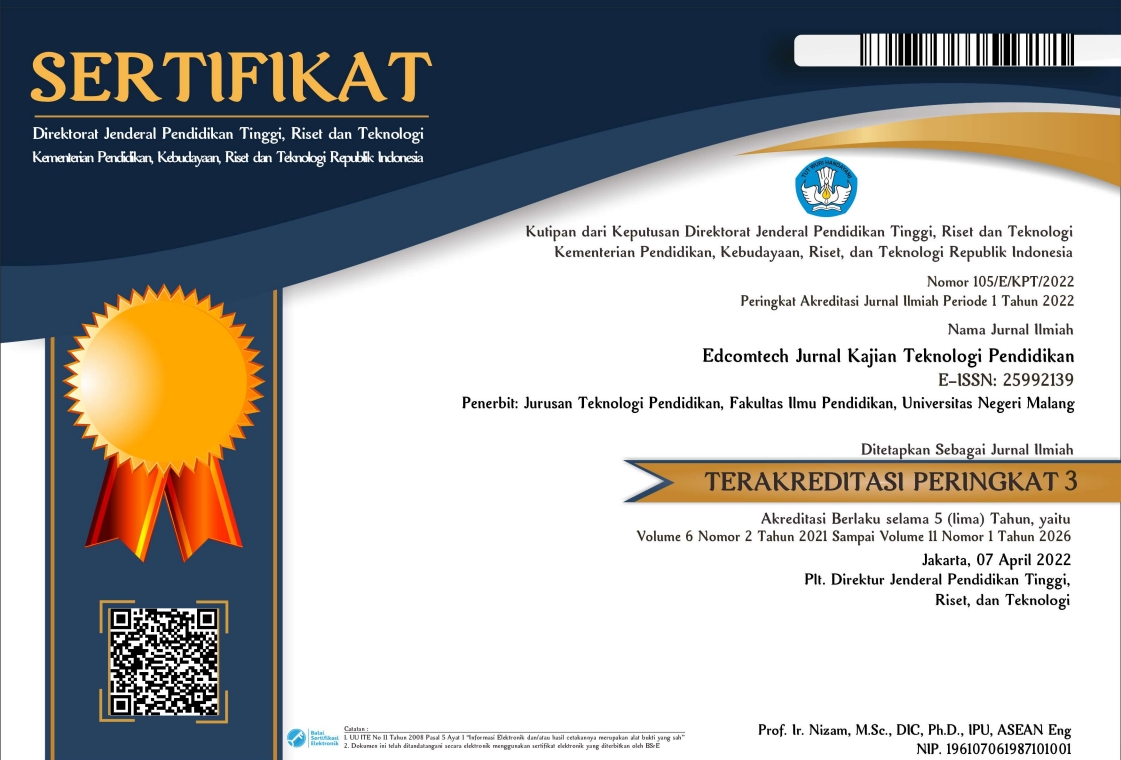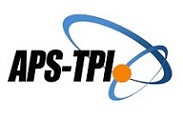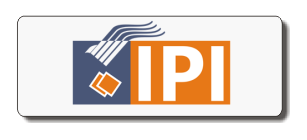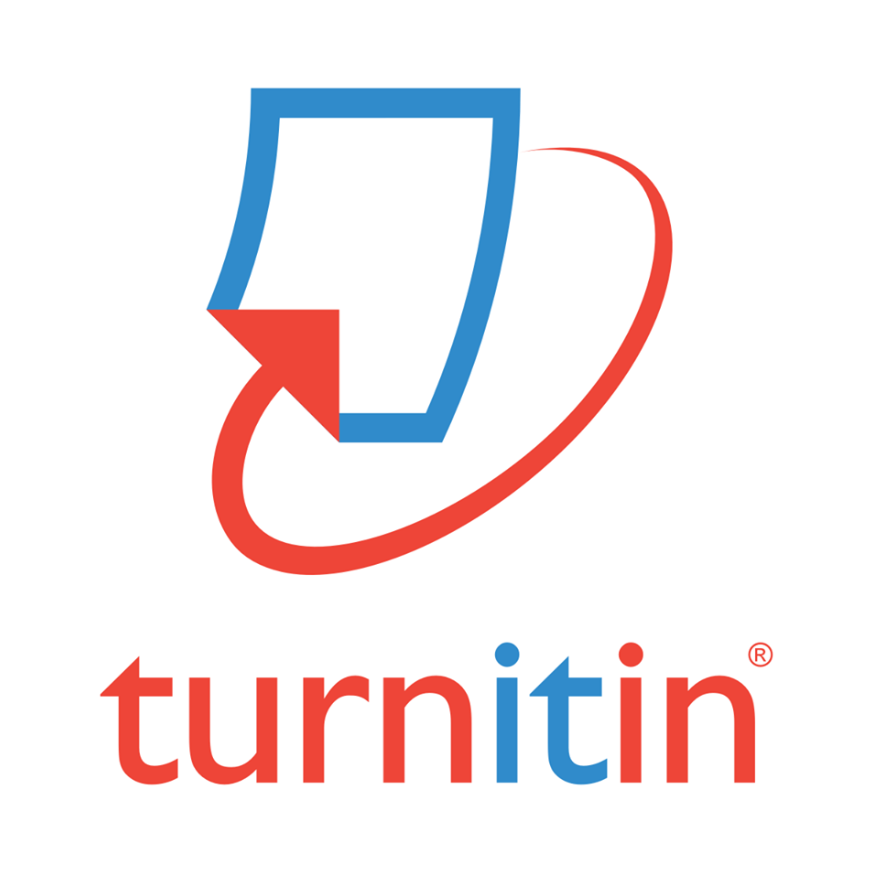The Development of Web-Based Learning Models as A Learning Medium for Students of Audio Video Electronics Competencies
Abstract
At present distance education has reached almost the entire archipelago. These developments occur a lot in higher education. This benefit is also brought about in secondary education, as seen in SMKN 1 Jetis, especially in the electronics field. Web media with URL ruangpakdedy.com was developed to answer the many electronic learning materials that exist in cyberspace but are still scattered, so the web is made to collect various sources of electronic material in one site. This ease is expected to increase skills that have a greater portion than cognitive knowledge in vocational education. The development used refers to the 4D Thiagarajan model by going through the planning process, material testing by material experts, and media testing by media experts, revisions, products tested on students with good results. As a complement on the web also added assignments that are connected to the LMS page and quiz.
Keywords
Full Text:
PDFReferences
Arsyad, A. (2011). Media pembelajaran. Jakarta: PT Raja Grafindo Persada.
Batsila, M., Tsihouridis, C., Vavougios, D., & Loannidis, G. (2015). Factors that Influence the Application of Web 2.0 Based Techniques for Instructional Purposes – A Case Study. International Journal of Emerging Technologies in Learning, 10(4), 15–21.
Caliskan, S., Guney, Z., Sakhieva, R., Vasbieva, D., & Zaitseva, N. (2019). Teachers’ Views on the Availability of Web 2.0 Tools in Education. International Journal of Emerging Technologies in Learning (IJET), 14(22), 70–81.
Chatwattana, P., & Nilsook, P. (2017). A Web-based Learning System using Project-based Learning and Imagineering. International Journal of Emerging Technologies in Learning (IJET), 12(05), 4–22.
Choi, Y., Choe, Y., & Oh, T. (2013). Future Direction for Next Generation Web. International Journal of Emerging Technologies in Learning (IJET), 8(6), 6–10.
El-Seoud, S. A., El-Sofany, H., & Karam, O. (2015). Semantic Web Architecture and its Impact on E-learning Systems Development. International Journal of Emerging Technologies in Learning (IJET), 10(5), 29–34.
Faizi, R., Chiheb, R., & Afia, A. E. (2015). Students’ Perceptions Towards Using Web 2.0 Technologies in Education. International Journal of Emerging Technologies in Learning (IJET), 10(6), 32–36.
Gawande, V. (2015). Development of Blended Learning Model based on the Perceptions of Students at Higher Education Institutes in Oman. International Journal of Computer Applications, 114, 38–45. doi: 10.5120/19946-1747
Guetl, C., Chang, V., Edwards, A., & Boruta, S. (2013). Flexible and Affordable Foreign Language Learning Environment based on Web 2.0 Technologies. International Journal of Emerging Technologies in Learning (IJET), 8(2), 16–28. doi: 10.3991/ijet.v8i2.2488
Hamad, M. M. (2015). Blended Learning Outcome vs. Traditional Learning Outcome. International Journal on Studies in English Language and Literature, 3(4), 75–78.
Jaimez-González, C. R., & Castillo-Cortes, M. (2020). Web Application to Support the Learning of Programming Through the Graphic Visualization of Programs. International Journal of Emerging Technologies in Learning (IJET), 15(06), 33. doi: 10.3991/ijet.v15i06.12157
Kapsalis, V. (2009). Implementation of an Assessment System Incorporating Web-based Parameterized Questions. International Journal of Emerging Technologies in Learning (IJET), 4(3), 20–28.
Kunandar. (2007). Guru Profesional Implementasi Kurikulum Tingkat Satuan Pendidikan (KTSP) dan Sukses dalam Sertifikasi Guru. Jakarta: PT Raja Grafindo Persada.
Kuswandi, D., Surahman, E., Thaariq, Z. Z. A., & Muthmainnah, M. (2018). K-Means Clustering of Student Perceptions on Project-Based Learning Model Application. 2018 4th International Conference on Education and Technology (ICET), 9–12. Malang, Indonesia: IEEE. doi: 10.1109/ICEAT.2018.8693932
Licks, G., Teixeira, A., & Luyten, K. (2018). Smart Makerspace: A Web Platform Implementation. International Journal of Emerging Technologies in Learning (IJET), 13(02), 140–156.
Lin, W. (2016). Human Resources Management of Track and Field Web Course in College Physical Education. International Journal of Emerging Technologies in Learning (IJET), 11(4), 95–102.
Linek, S., Schafrick, A., & Tochtermann, K. (2013). Just for the Image? The Impact of Web 2.0 for Public Institutions. International Journal of Emerging Technologies in Learning (IJET), 8(2013). Retrieved from https://www.learntechlib.org/p/45223/
Mohorovi, S., Tijan, E., & Čišić, D. (2010). Using Web Content Management Systems in University E-Commerce Courses. International Journal of Emerging Technologies in Learning (IJET), 5(2). Retrieved from https://www.learntechlib.org/p/44936/
Mulyatiningsih, E. (2011). Riset terapan bidang pendidikan dan teknik. Yogyakarta: UNY Press.
Prasojo, L., Habibi, A., Mukminin, A., Sofyan, S., Indrayana, B., & Anwar, K. (2020). Factors Influencing Intention to Use Web 2.0 in Indonesian Vocational High Schools. International Journal of Emerging Technologies in Learning (IJET), 15(5), 100–118.
Putra, N. (2012). Research & development penelitian dan pengembangan: Suatu pengantar. Jakarta: PT Raja Grafindo Persada.
Sanjaya, W. (2010). Strategi Pembelajaran Berorientasi Standar Proses Pendidikan. Jakarta: Kencana.
Shawar, B. A. (2015). Evaluating web accessibility of educational websites. International Journal of Emerging Technologies in Learning, 10(4).
Slameto. (2010). Belajar dan Faktor-Faktor yang Mempengaruhinya. Jakarta: Rineka Cipta.
Sugiyono. (2003). Metode Penelitian Administrasi Dilengkapi dengan Metode R&D. Bandung: CV. Alfabeta.
Thiagarajan, S., Semmel, D. S., & Semmel, M. I. (1974). Instructional development for training teachers of exceptional children. Minesota: The Council for Exepttional Children.
Usta, E. (2011). The Effect Of Web-Based Learning Environments On Attitudes Of Students Regarding Computer And Internet. Procedia - Social and Behavioral Sciences, 28, 262–269. doi: 10.1016/j.sbspro.2011.11.051
Wang, L. (2016). Personalized Teaching Platform Based on Web Data Mining. International Journal of Emerging Technologies in Learning (IJET), 11(11), 15–20.
Widoyoko, S., & Putro, E. (2012). Teknik Penyusunan Penelitian. Yogyakarta: Pustaka Belajar.
DOI: http://dx.doi.org/10.17977/um039v6i12021p100
Refbacks
- There are currently no refbacks.
Copyright (c) 2021 Dedy Hendriana, Rufi’i Rufi’i, Hartono Hartono

This work is licensed under a Creative Commons Attribution-ShareAlike 4.0 International License.
Edcomtech: Jurnal Kajian Teknologi Pendidikan published by Department of Educational Technology, Faculty of Education, State University of Malang in Collaboration with Asosiasi Program Studi Teknologi Pendidikan Indonesia (APS TPI) and Ikatan Profesi Teknologi Pendidikan Indonesia (IPTPI) with MoU.
Publisher Address:
Lab. Teknologi Pendidikan, Gd.E2, Lt.1
Fakultas Ilmu Pendidikan Universitas Negeri Malang
Jalan Semarang No 5, Kota Malang Kode Pos 65145
Email: edcomtech.fip@um.ac.id
========================================================================================================
| INDEXED BY | TOOLS | PLAGIARISM CHECK | ARTICLE TEMPLATE |
|

Edcomtech is licensed under a Creative Commons Attribution-ShareAlike 4.0 International License.
Edcomtech Statistics (Since July 13th, 2020)












1.png)








